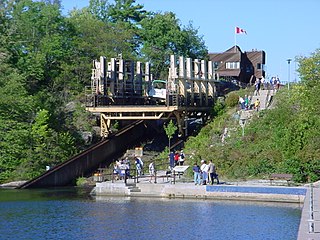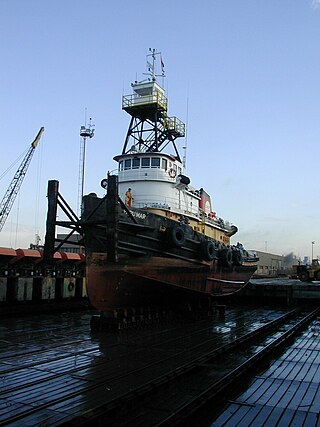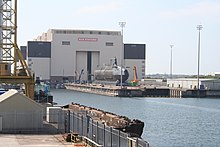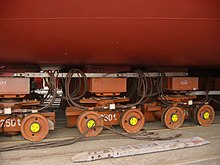
A marina is a dock or basin with moorings and supplies for yachts and small boats. A marina differs from a port in that a marina does not handle large passenger ships or cargo from freighters.

A dry dock is a narrow basin or vessel that can be flooded to allow a load to be floated in, then drained to allow that load to come to rest on a dry platform. Dry docks are used for the construction, maintenance, and repair of ships, boats, and other watercraft.

A crane is a machine used to move materials both vertically and horizontally, utilizing a system of a boom, hoist, wire ropes or chains, and sheaves for lifting and relocating heavy objects within the swing of its boom. The device uses one or more simple machines, such as the lever and pulley, to create mechanical advantage to do its work. Cranes are commonly employed in transportation for the loading and unloading of freight, in construction for the movement of materials, and in manufacturing for the assembling of heavy equipment.

The word dock in American English refers to one or a group of human-made structures that are involved in the handling of boats or ships. In British English, the term is not used the same way as in American English, it is used to mean the area of water that is next to or around a wharf or quay. The exact meaning varies among different variants of the English language.

A boat lift, ship lift, or lift lock is a machine for transporting boats between water at two different elevations, and is an alternative to the canal lock.

A slipway, also known as boat ramp or launch or boat deployer, is a ramp on the shore by which ships or boats can be moved to and from the water. They are used for building and repairing ships and boats, and for launching and retrieving small boats on trailers towed by automobiles and flying boats on their undercarriage.

A diving support vessel is a ship that is used as a floating base for professional diving projects. Basic requirements are the ability to keep station accurately and reliably throughout a diving operation, often in close proximity to drilling or production platforms, for positioning to degrade slowly enough in deteriorating conditions to recover divers without excessive risk, and to carry the necessary support equipment for the mode of diving to be used.

A dive boat is a boat that recreational divers or professional scuba divers use to reach a dive site which they could not conveniently reach by swimming from the shore. Dive boats may be propelled by wind or muscle power, but are usually powered by internal combustion engines. Some features, like convenient access from the water, are common to all dive boats, while others depend on the specific application or region where they are used. The vessel may be extensively modified to make it fit for purpose, or may be used without much adaptation if it is already usable.

Tandanor is an Argentine shipyard located south of Buenos Aires port which together with Almirante Storni yard constitutes CINAR dedicated to shipbuilding and ship repair. It currently harbors ships from around the globe due to its international renown. Its competitive advantage springs from its Syncrolift: a shiplifting platform that allows vessels to be dry docked and perform simultaneous repairs on its six slipways. In April 2019, Tandanor signed a cooperation agreement with City Bank.

A ship cradle is a rig designed to hold a ship or boat upright on dry land to allow the vessel to be built or repaired. The vessel is held in place in the cradle by wooden chocks, cables, sand bags or restraining fixtures on the cradle. Ship cradles are made of timber or steel and are usually built adjacent the seashore, lake or river side or on the floor of a dry dock.

A patent slip or marine railway is an inclined plane extending from shoreline into water, featuring a "cradle" onto which a ship is first floated, and a mechanism to haul the ship, attached to the cradle, out of the water onto a slip. The marine railway was invented by a Scot, Thomas Morton, in the early 19th century, as a cheaper alternative to dry docks for marine vessel repairs, in particular below waterline. Larger modern marine railways can handle vessels of thousands of tons.

A semi-trailer is a trailer without a front axle. The combination of a semi-trailer and a tractor truck is called a semi-trailer truck.

A flatbed truck is a type of truck the bodywork of which is just an entirely flat, level 'bed' with no sides or roof. This allows for quick and easy loading of goods, and consequently they are used to transport heavy loads that are not delicate or vulnerable to rain, and also for abnormal loads that require more space than is available on a closed body. Flatbed trucks can be either articulated or rigid.

A tail lift is a mechanical device permanently installed on the rear of a work truck, van, or lorry, and is designed to facilitate the handling of goods from ground level or a loading dock to the level of the vehicle bed, or vice versa.

Devonshire Dock Hall is a large indoor shipbuilding and assembly complex that forms part of the BAE Systems shipyard in the Barrow Island area of Barrow-in-Furness, Cumbria, England.

Syncrolift AS is a supplier of ship-handling equipment for shipyards. It manufactures the Syncrolift shiplift.
A flatbed trolley a common form of freight transport in distribution environments, for moving bulk loads. Trolleys can aid in reducing effort required to move a load by allowing the user to pull or push instead of lift and carry. A very simple design offers a basic flat platform with four casters and a fixed handle which is used to either push or pull the platform with the load on the platform. Without a flat surface it becomes an open frame trolley and without a handle it is a bogie or dolly.
Raymond Pearlson is an American marine engineer and the inventor of the Syncrolift System, which was designed to both launch ships and lift them out of the water for repair.

A travel lift or travelift is a specialised type of crane used for lifting boats out of the water and transporting them around docks or marinas. These cranes allow boats with masts or tall superstructure to be transported around hard stands as the tall upper structure can pass through the open end of the crane framework before lifting and after setting down.




















